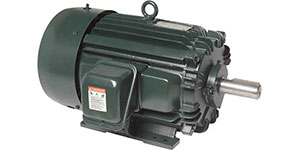How Do Motors Fail?
 The proper application and selection of low voltage motors can be a demanding task.
The proper application and selection of low voltage motors can be a demanding task.
A good starting point would be to consider why motors fail in the first place. In this issue, Toshiba will investigate some of the reasons why motors fail. If you talk to your local rewind shop, you would most likely find that they also experience very similar, if not identical, reasons described in this issue.
Bearing Failures (60 to 70%)
- Over/Under Lubrication
- Misalignment/Belt Tension
- Contaminants/Compatibility
- Vibration
- Thrust
- High Ambient
- Bearing Currents
- L10 Fatigue
- Cause of Motor Bearing Failure
Studies show that bearings fail more often than insulation systems, and the number one cause of bearing failure is due to over/under lubrication. Improper lubrication causes a heat buildup in the bearing cavity, and the added heat causes the grease to break down prematurely, eventually resulting in failure. Ultimately, many of these bearing failures are a result of the bearing exceeding its temperature limits in one form or another.
When evaluating motor bearing systems, the following important considerations should be made:
- Bearing Temperature Rise: Temperature is the root cause of many of the failures listed above. A larger thermal margin in the bearing design is ideal. For every 15°C temperature decrease, the life of your bearing doubles.
- Grease Nipples & Relief Valves: This is done to allow greasing and prevent over greasing.
- Sealed or Open-Style Bearings: Sealed bearings do not require as much greasing maintenance and are commonly used on smaller frames that are often installed in hard-to-reach places. As frames sizes increase, a transition to open-style bearings is important to allow for reduced temperature rises, which in turn extends grease life and greasing intervals.
- Bearing Clearance Rating: C3 'loose' fitting bearings allow for thermal growth.
- Shaft Seals: To protect against contaminants, a V-ring seal (forsheda seal) is better than a flat seal. Librium-type seals provide IP55 protection and industry-leading bearing protection.
- Bearings Sizes on DE & ODE: Larger bearings run on lower temperatures. They can handle larger radial loads, have longer L10 lives to extend the effects of fatigue, and are not as sensitive to small misalignments. 300 series bearings are wider and have much larger outside diameters.
- Inner Bearing Caps: Caps can prevent bearings from failing by damage caused to the stator and rotor.
- Drain & Breather Plugs: These allow for water to escape and prevents water from entering the motor.
- Grease Type: Premium-grade polyurea or lithium based greases extend grease life, have wider operating temperature ranges, contain rust and oxidation inhibitors, run quieter, and have higher operating speed capabilities.

